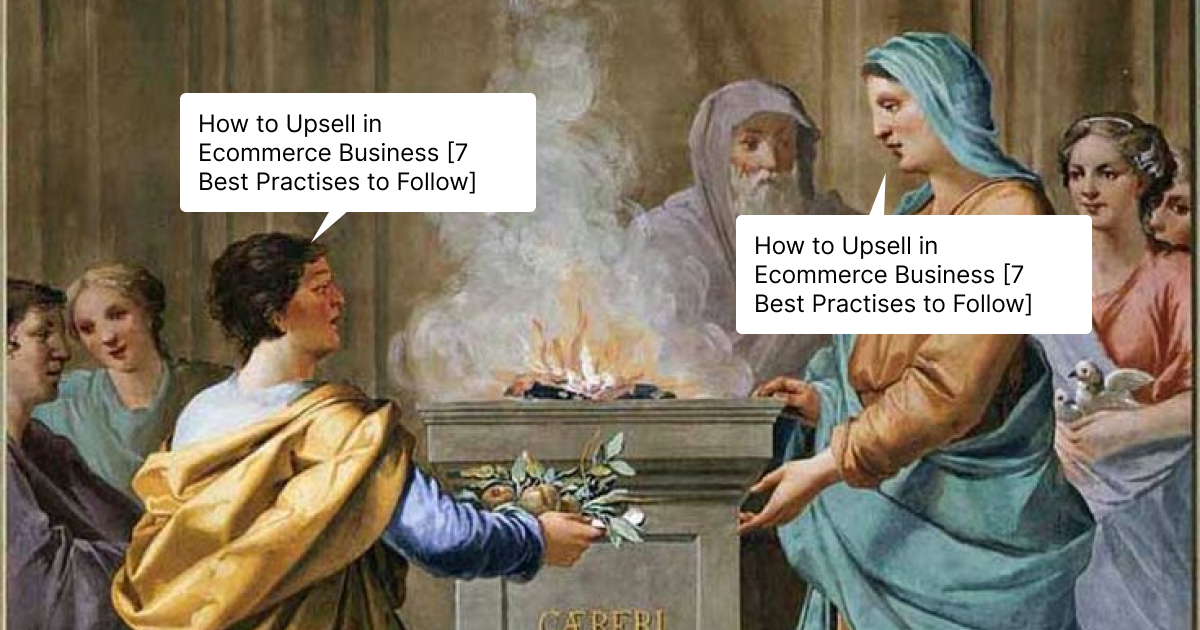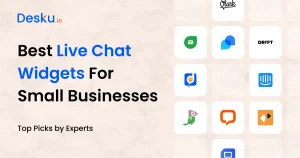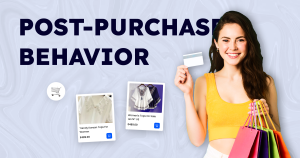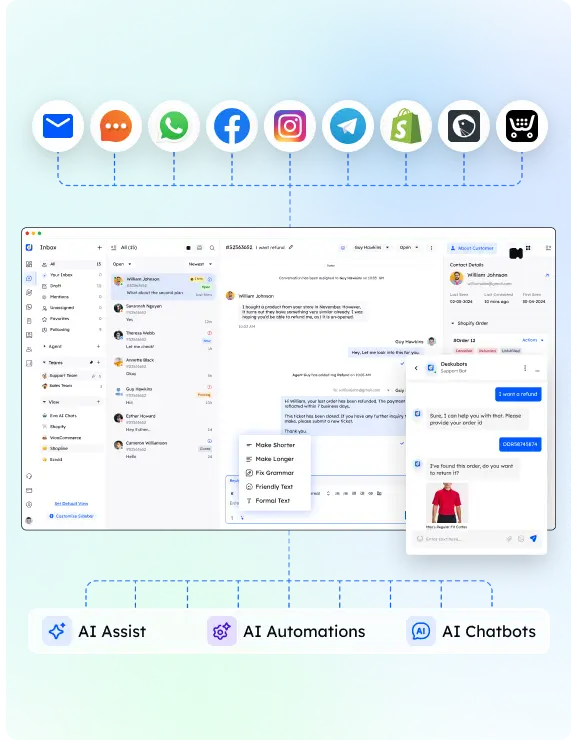If you’re in the e-commerce business and you’re keen to grow, you’re likely on the hunt for effective tactics to boost your sales. One powerful growth strategy you should consider is upsell in ecommerce business.
But wait, it’s not just about pushing pricier items to your customers. It’s more about getting to know their needs and guiding them toward a product or service that provides better value.
So, how can you do this effectively? And, crucially, how can you do it in a way that not only increases your revenue but also leaves your customers feeling happy and not taken advantage of?
Key Takeaways
Are you running and automating your e-commerce business and looking to expand? If so, you’re probably searching for efficient ways to increase your sales. One effective method to consider is upselling.
But hold on, it’s not as simple as just promoting more expensive items to your customers. It involves understanding their needs and guiding them towards a product or service that offers them better value.
So, the question is, how can you pull this off effectively? More importantly, how can you do so in a way that not only improves your revenue but also leaves your customers feeling satisfied and not exploited?
Let’s get into the details of upselling in e-commerce and reveal the top seven practices to nail it. Sounds interesting, right? It should be, because the knowledge ahead could potentially change your sales strategy and significantly boost your profitability.
![How To Upsell In Ecommerce [ 7 Best Practices To Follow ] - Desku All in one ai chatbot and automation crm for ecommerce brands](https://desku.io/wp-content/uploads/2024/04/all-in-one-ecommerce-chatbot-and-helpdesk-1024x355.png)
What is Ecommerce Upselling?
In e-commerce, upselling plays a crucial role. It’s a sales technique where you, as a business, suggest a pricier or premium version of the product that the customer is already interested in. The goal is to increase the total sale price and, consequently, the profits. It’s not just about making more money, though. It’s about adding value for your customers and enhancing your sales profits.
Think about it like this. When you upsell successfully, you can increase the average order value by encouraging customers to spend more. But it’s not about tricking them into buying something they don’t need. Instead, it’s about showing them better options that offer more benefits. Essentially, you’re helping them make a better buying decision.
In the online world, there are several ways you can upsell. For example, you can use pop-ups, customer support agents, and prompts on your website. Each of these techniques gives you a chance to convince your customers to buy a better version of a product at a higher price.
Know the difference: Upselling vs. cross-selling
![How To Upsell In Ecommerce [ 7 Best Practices To Follow ] - Desku Cross-selling and upselling are two essential strategies in ecommerce that can increase revenue. Upselling involves persuading a customer to purchase a higher-end product or upgrade, while cross-selling is encouraging them to buy](https://desku.io/wp-content/uploads/2024/02/image-62.png)
Image Source : Zapier
If you’re looking to give a boost to your sales profits, it’s crucial to understand the difference between upselling and cross-selling. Both are powerful strategies that can significantly raise your revenue, but it’s important to know when to apply each one.
Upselling and cross-selling might seem similar, but they’re actually quite different. Upselling involves convincing customers to go for a pricier version of the product they’re already interested in. This could be due to better quality or higher functionality, giving them more value for their money.
Meanwhile, cross-selling is all about tempting customers to buy a product that goes well with what they’re already purchasing. This can greatly improve their overall experience with the product they’re buying.
So here’s the lowdown:
- Upselling means encouraging customers to opt for higher-end products, which in turn increases the total purchase price.
- Cross-selling is about adding value to the customer’s purchase by suggesting related products or accessories, thus enhancing the overall transaction value.
- Both strategies aim to boost revenue. However, the choice between upselling and cross-selling should be based on the specific customer and the situation at hand.
7 Strategies for upsell in Ecommerce Business
If you’re looking to up your ecommerce game and increase profits, you might want to think about stepping up your upselling techniques.
How about showing your customers comparisons of different products? Or maybe you could showcase some upgrades for their consideration?
You could even suggest alternative products that have higher ratings. These approaches could really make a difference to your bottom line.
1 Offer side-by-side alternative comparison
Ever thought about how to ramp up your Ecommerce sales game? One trick is to put your products side by side and let them do the talking. By comparing your items, you’re not only showing off the best bits of the more expensive ones, but also making your customer’s decision a bit easier.
Here’s how you can do it:
- Show off your other products next to the one your customer is looking at. Make sure to highlight those extra features that come with the pricier option.
- Have you thought about using a comparison table? It’s a clear, easy way for customers to see what they’re gaining from spending a little more.
- How about a bit of a nudge? Show them the price difference but also throw in a ticking clock or a low stock warning.
Doing an upsell this way is a win-win. Your customers learn more about what you’re offering, and you might just persuade them to go for the upgrade.
2 Display upgrades
You know, in the bustling online shopping space, showing off those snazzy upgrades can really boost sales. It’s like dangling a carrot in front of customers – a shinier, more advanced carrot that packs more punch.
This approach nudges the customer to think, ‘Maybe I should go for the better version,’ mixing the need for practicality with the allure of something top-tier.
And guess what? With a top-grade online shopping platform, your digital store can effortlessly show these upgrades to your potential buyers.
![How To Upsell In Ecommerce [ 7 Best Practices To Follow ] - Desku All in one ai chatbot and automation crm for ecommerce brands](https://desku.io/wp-content/uploads/2024/04/all-in-one-ecommerce-chatbot-and-helpdesk-1024x355.png)
3 Offer alternatives with better ratings
Using customer reviews to suggest alternatives with better ratings can make a real difference in your online store’s upselling strategy. This approach works wonders because it capitalizes on the credibility of peer reviews.
- Spotlight High-rated Alternatives: Try highlighting items with higher ratings next to the product a customer has selected on your online store.
- Convince with Ratings: Use these impressive ratings as a selling tool to convince your customer to spend a little extra on a product with better reviews.
- Take a Leaf out of Amazon’s Book: Amazon has been extremely successful with this upselling and cross-selling strategy. They skillfully offer customers options with higher ratings, significantly increasing their upsells.
4 Create product bundles
Creating a collection of products can be a fantastic approach to get your customers’ attention and boost your sales. This method can really help you expand your online store by motivating buyers to put more items in their shopping basket. This approach can lead to larger purchases, increasing your average sale.
Carefully selected product collections can create a rush to buy, tempting customers to grab a fantastic offer before it disappears. This upselling method not only helps boost your sales but also improves the shopping experience. When buyers feel like they’re getting more bang for their buck, they’re more likely to buy.
5 Create urgency and need
A sense of urgency and need can be a game changer in your ecommerce upselling strategy. So, how do you introduce this in your upsell? Here’s the scoop:
- Spotlight on limited availability or time-sensitive offers: You want your customers to feel that they’ve to move quickly to grab the deal.
- Highlight the savings: Clearly show how much they’ll save if they go with the upsell, underlining the benefits.
- Craft appealing product descriptions: Write product descriptions that are so attractive, the upsell becomes too good to pass up.
By giving a conversational twist to these points, you can make your upselling strategy more effective.
Avoid AI jargon and overused words, and focus on a more human writing style to better engage with your customers. Remember, Google also appreciates this approach for better indexing.
![How To Upsell In Ecommerce [ 7 Best Practices To Follow ] - Desku All in one ai chatbot and automation crm for ecommerce brands](https://desku.io/wp-content/uploads/2024/04/all-in-one-ecommerce-chatbot-and-helpdesk-1024x355.png)
6 Focus on benefits rather than features
Understanding the power of urgency in your upsell strategy is important, but it’s equally vital to highlight the advantages, rather than just the traits, of your more expensive products.
Suppose we look at an example of upselling, where online businesses center their focus on the customer’s value. The point isn’t simply to state that an upsell item offers more storage or works at a faster speed. It’s about helping the customer understand how these features will improve their experience or save them precious time.
These methods can help boost the average order value. It’s about showing customers how personalizing their online shopping experience can better their lives or satisfy their needs. Yes, the end goal of upselling is to boost profits, but the real opportunity to upsell comes from giving your customers true value.
7 Personalise the recommendation
In the online shopping world, a great way to increase sales is by making your suggestions more personalised. Think about it, instead of just offering a more expensive version of an item, why not offer something that really fits your customer’s needs?
Let’s break it down:
- After-Purchase Suggestions: So, your customer just bought something. What next? Why not drop them an email offering products related to their recent purchase? Say they just bought a new DSLR camera – a suggestion for a new camera lens could be a great fit!
- Upselling and Cross-Selling: These might sound like jargon, but they’re pretty simple. Upselling? That’s when you offer a more expensive item. Cross-selling? That’s when you offer an additional product that goes well with their main purchase.
- Making Suggestions Personal: This is where it gets really interesting. You can use info on your customer’s browsing and buying habits to suggest products that they’ll love.
![How To Upsell In Ecommerce [ 7 Best Practices To Follow ] - Desku All in one ai chatbot and automation crm for ecommerce brands](https://desku.io/wp-content/uploads/2024/04/all-in-one-ecommerce-chatbot-and-helpdesk-1024x355.png)
What tools help in automating upselling in Business?
If you’re looking to boost your ecommerce business, I’ve got a couple of tools to share with you that can automate the upselling process, and help you bump up those sales numbers.
First up, there’s a nifty tool called Beeketing (now Shopbase ). What’s cool about it’s that it keeps an eye on your customer’s shopping behavior and then pops up with product suggestions they might fancy, right after they’ve added something to their cart. It’s all about timing, right?
Then there’s Candy Rack Shopify App. This one’s a bit different. When your customer is all set to checkout, a pop-up window appears with an upsell offer. The smart bit? The offer is usually for a product that goes hand in hand with what they’re buying, making it a value-add for the customer.
Finally, you might want to check out Personalizer by LimeSpot. This tool is a bit techy, using smart algorithms to offer personalized product recommendations to your customers. The result? You guessed it – more chances of upselling, and a smoother shopping journey for your customers.
There you have it! A few tech-savvy tools to help automate upselling and ramp up those sales.










